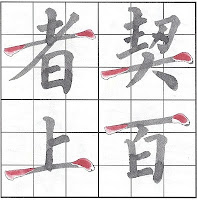Having been practising Wang Xizhi’s ‘Shiqi Tie’ for about four months, I now have a better understanding on the meaning on ‘sheng-shu-sheng’ stages of learning Chinese calligraphy.
The Chinese word ‘sheng’ has many meanings. In the first stage of learning Chinese calligraphy, it refers to the stage of unfamiliarity. While there are a number of things one should pay attention to at this stage, I think two things are most important on getting one familiar with writing the words: the number of strokes that form the words and the sequence of writing the strokes. After one has a better idea of these two aspects of writing, one can proceed to work other things: how and when to start a stroke, when to use finger or wrist to turn the brush, when to use various techniques of brush-turning, the correct space between the strokes, the position of the start and end of strokes, etc.
The second stage refers to the skilled or proficient (shu) stage, this is when you can start to work on the relationship between the words and the composition of the calligraphy. At this stage, one should almost be able to memorise the shape and methods of writing the strokes of the words so that one can focus on the placing the words at the right positions. The aim of this stage is to be able to write the whole piece in a way that the words and composition are flow smoothly.
The first two stages are what we called the methods (fa) of Chinese art. The last stage of ‘sheng’ reflects the very important concepts of ‘vivid’ and ‘lively’ in Chinese aesthetics. How to be vivid and lively? The only way to achieve that is that art work must be natural. The unity of methods and naturalness reflects the traditional aesthetic ideal of a great work of art as a living and organic pattern. Most of us may not be able to achieve such high level of art in our life time.
Shown here is a piece of my practice work.
.
临摹了《十七帖》大约四个月,对学习书法的《生熟生》概念有了深一层的认识。
中文‘生’有不少意义。在学习书法的第一阶段指‘生疏’的意思。在这阶段,有不少的东西要我们去注意,但我想其中两个最重要:注意每个字有几个笔划与书写笔顺。对这两方面有了较好的认识之后,就可以开始注意书写的其它的事项了:如何及何时起笔、何时用指何时用腕运笔、何时用何种转笔法、笔划间的布白及起笔及收笔的位置,等等。
第二阶段是熟练阶段,这时开始注意书写字与字间的关系与章法。在这个阶段,我们应该几乎可以熟记字形及笔划的书写,这样就可以集中把字写在正确的位子。这个阶段的目的是要使结字与章法流而畅。
前两个阶段是中国艺术中所谓的‘法’。最后一个阶段反映的是中国美学里‘生动活力’的概念。达到生动活力的唯一法门就是要自然。方法与自然的统一反映传统美学中认为伟大艺术作品应有活力,同时是有机形式。对我们中很多人来说,一生中可能都没有法子达到这个阶段。
这里展示的是一幅临摹之作。






















